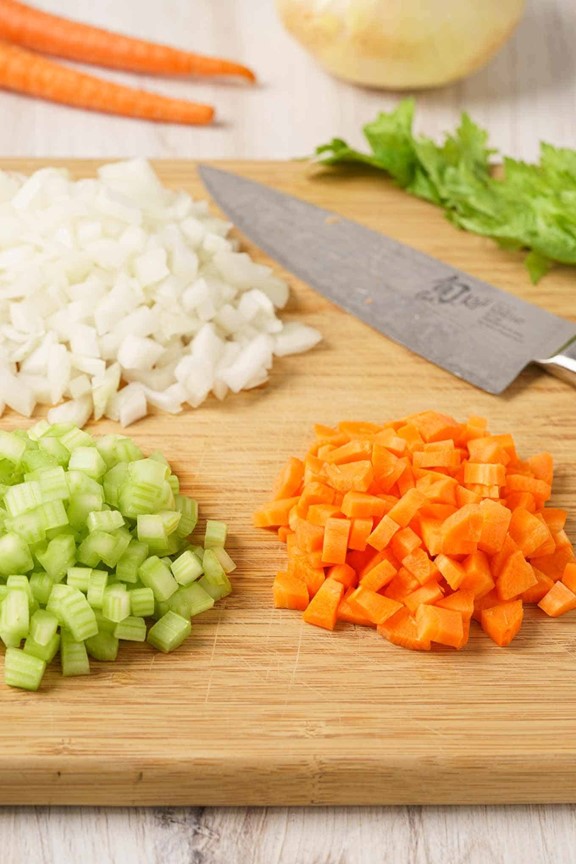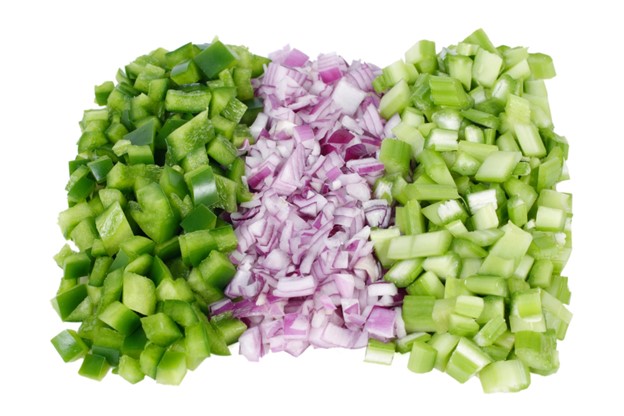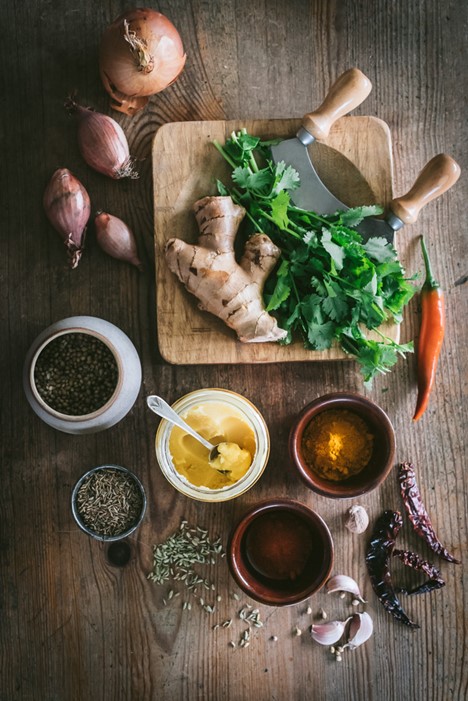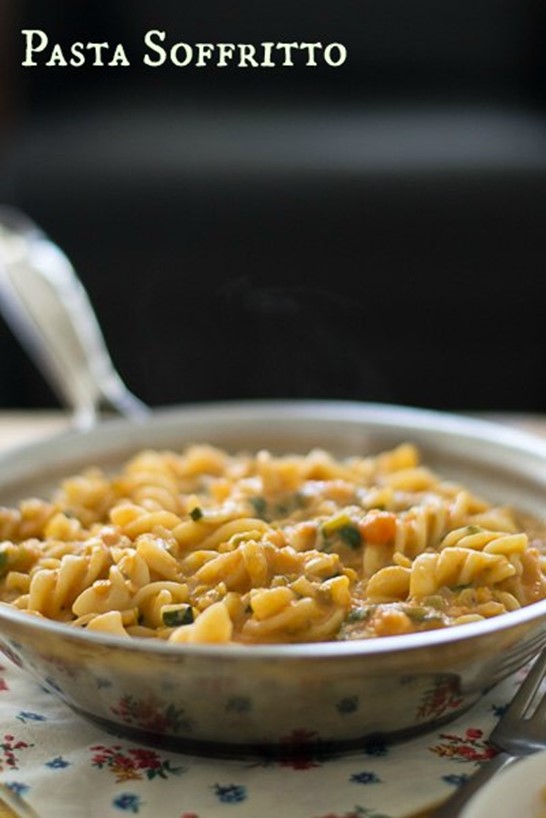Mirepoix—A FUNDAMENTAL Food Base!
One of the first lessons students in culinary school learn is all about mirepoix (meer-pwah)—what it is, how to make it, and why it’s used. My son is a chef in Jackson, WY, and each time we cook together, he always starts us off by making a mirepoix.
First, WHY IT’S USED—what’s the big deal with mirepoix? He taught me that it’s a powerful source of flavor—so much so that it’s key to most restaurant recipes. It’s a fundamental food base. So in the off-chance that we have any Cook’n readers out there that aren’t well acquainted with this fundamental food base, let’s talk.

Next, WHAT IT IS: Mirepoix is an aromatic blend of ingredients made to bring flavors to foods like stews, soups, stocks, and broth. This trinity food is made by slowly cooking carrot, onion, and celery to “sweat” out the flavor and create a delicious base for other recipes to be built upon. The vegetables are typically strained out of the recipe before the meal is served. It is a staple in French cuisine.
Lastly, HOW TO MAKE IT (in 5 easy steps). It’s always made in a ratio of 2:1:1 (2 parts onion, 1 part carrot, and 1 part celery).

You’ve likely been using a mirepoix throughout your cooking experience because there are basic recipes that always include it. For instance, chicken and turkey noodle soup, chicken fricassee, beef stew, meatloaf, shrimp scampi, and many potato soup recipes.
It’s interesting to note that the traditional French mirepoix blend is just one variation of aromatic bases. Cultures worldwide have their own variation on this concept of a flavor base.
There’s the Cajun Holy Trinity, also known as Cajun Trinity or just Holy Trinity, is an aromatic base made with onion, celery, and green bell pepper. The Cajun Trinity is used in many Cajun and Creole dishes including jambalaya and gumbo.

The Italian soffritto is made with minced onion, celery, and carrot heated in olive oil, but the big difference between it and a French mirepoix is the addition of fresh herbs like parsley, garlic, and fennel. Some chefs may even add a cured meat, like pancetta or prosciutto, to amplify the flavor. Italian soffritto is often used to make minestrone soup, pasta e Ceci, and Italian wedding soup.
A Spanish (or Latin) soffritto is made with onion, tomatoes, bell peppers, and garlic. The vegetables are gently fried with herbs and olive oil. It’s the base for paella, sancocho, and rice-and-bean dishes.

The German version, a suppengrun (translating to “soup greens”), is made with carrots, celeriac (celery root), and leeks. Herbs, like parsley and thyme, and root vegetables like rutabaga and onions are often added to this aromatic base. Due to cold German winters, the ingredients in suppengrun are hearty and have long shelf lives. Suppengrun is used to make Fuhrmannsbraten (braised beef roast), potato soup, and Sauerbraten (German-style oxtail soup).
The Cantonese style is made with a Chinese aromatic blend that contains scallions, ginger, and garlic. These ingredients are cooked in oil and are used to make a variety of lo mein noodle and stir-fry dishes.
Then there’s the East Indian flavor base is made by cooking onions, garlic, and chilies in ghee. Ginger (and a few other spices) is often added to this regional aromatic trinity. This Indian mirepoix equivalent is used to make traditional curry dishes.

And here’s a little tip: As a way to encourage more mirepoix use, and to save time, pre-prep or freeze mirepoix components. One note: Frozen mirepoix, once thawed, may have a softer texture than using fresh mirepoix, so it's best for soup recipes.
Finally, since many recipes call for straining the mirepoix ingredients out of the liquid they create, it’s good to know what else you can do with these cooked veggies. While it can always be composted, it’s also delicious blended into gravy as a healthy thickener. You can also add it to the mix for making veggie burgers, and seriously consider pureeing it and whipping it into mashed potato recipes.
I’ll close with a very good recipe from www.kannammacooks.com for a crowd-pleasing recipe that uses an Italian soffritto. See what you think:

SOFFRITTO MIXTURE
2 medium-sized onions
3 carrots
6 to 7 stalks celery
OTHER INGREDIENTS
2 1/2 cups dry pasta cooked and drained
2 tablespoons extra-virgin olive oil
1 teaspoon dried Italian seasoning
4 to 5 cloves garlic finely minced
1 teaspoon salt
8 very ripe tomatoes skins and seeds removed
1 teaspoon apple cider vinegar
1 teaspoon sugar
freshly ground pepper to taste
1/2 cup cream
7 to 8 fresh basil leaves
Directions:
Add Recipe to Cook'n
First, WHY IT’S USED—what’s the big deal with mirepoix? He taught me that it’s a powerful source of flavor—so much so that it’s key to most restaurant recipes. It’s a fundamental food base. So in the off-chance that we have any Cook’n readers out there that aren’t well acquainted with this fundamental food base, let’s talk.

Next, WHAT IT IS: Mirepoix is an aromatic blend of ingredients made to bring flavors to foods like stews, soups, stocks, and broth. This trinity food is made by slowly cooking carrot, onion, and celery to “sweat” out the flavor and create a delicious base for other recipes to be built upon. The vegetables are typically strained out of the recipe before the meal is served. It is a staple in French cuisine.
Lastly, HOW TO MAKE IT (in 5 easy steps). It’s always made in a ratio of 2:1:1 (2 parts onion, 1 part carrot, and 1 part celery).
- Start by peeling your onion and thoroughly washing your carrots and celery so they are perfectly clean.
- Chop your vegetables according to the 2:1:1 ratio. Size the cuts according to your recipe.
- Once you have your mirepoix ready, heat your fat (usually butter or olive oil) on a low heat in a skillet or Dutch oven.
- Add the vegetables and cook the vegetables on a medium-low heat for about 10 minutes or until they are soft and translucent. Do not allow the vegetable to brown and caramelize.
- Once translucent, remove the mirepoix vegetables and proceed with the rest of your recipe.

You’ve likely been using a mirepoix throughout your cooking experience because there are basic recipes that always include it. For instance, chicken and turkey noodle soup, chicken fricassee, beef stew, meatloaf, shrimp scampi, and many potato soup recipes.
It’s interesting to note that the traditional French mirepoix blend is just one variation of aromatic bases. Cultures worldwide have their own variation on this concept of a flavor base.
There’s the Cajun Holy Trinity, also known as Cajun Trinity or just Holy Trinity, is an aromatic base made with onion, celery, and green bell pepper. The Cajun Trinity is used in many Cajun and Creole dishes including jambalaya and gumbo.

The Italian soffritto is made with minced onion, celery, and carrot heated in olive oil, but the big difference between it and a French mirepoix is the addition of fresh herbs like parsley, garlic, and fennel. Some chefs may even add a cured meat, like pancetta or prosciutto, to amplify the flavor. Italian soffritto is often used to make minestrone soup, pasta e Ceci, and Italian wedding soup.
A Spanish (or Latin) soffritto is made with onion, tomatoes, bell peppers, and garlic. The vegetables are gently fried with herbs and olive oil. It’s the base for paella, sancocho, and rice-and-bean dishes.

The German version, a suppengrun (translating to “soup greens”), is made with carrots, celeriac (celery root), and leeks. Herbs, like parsley and thyme, and root vegetables like rutabaga and onions are often added to this aromatic base. Due to cold German winters, the ingredients in suppengrun are hearty and have long shelf lives. Suppengrun is used to make Fuhrmannsbraten (braised beef roast), potato soup, and Sauerbraten (German-style oxtail soup).
The Cantonese style is made with a Chinese aromatic blend that contains scallions, ginger, and garlic. These ingredients are cooked in oil and are used to make a variety of lo mein noodle and stir-fry dishes.
Then there’s the East Indian flavor base is made by cooking onions, garlic, and chilies in ghee. Ginger (and a few other spices) is often added to this regional aromatic trinity. This Indian mirepoix equivalent is used to make traditional curry dishes.

And here’s a little tip: As a way to encourage more mirepoix use, and to save time, pre-prep or freeze mirepoix components. One note: Frozen mirepoix, once thawed, may have a softer texture than using fresh mirepoix, so it's best for soup recipes.
Finally, since many recipes call for straining the mirepoix ingredients out of the liquid they create, it’s good to know what else you can do with these cooked veggies. While it can always be composted, it’s also delicious blended into gravy as a healthy thickener. You can also add it to the mix for making veggie burgers, and seriously consider pureeing it and whipping it into mashed potato recipes.
I’ll close with a very good recipe from www.kannammacooks.com for a crowd-pleasing recipe that uses an Italian soffritto. See what you think:

Tuscan Pasta Soffritto
Ingredients:
SOFFRITTO MIXTURE
2 medium-sized onions
3 carrots
6 to 7 stalks celery
OTHER INGREDIENTS
2 1/2 cups dry pasta cooked and drained
2 tablespoons extra-virgin olive oil
1 teaspoon dried Italian seasoning
4 to 5 cloves garlic finely minced
1 teaspoon salt
8 very ripe tomatoes skins and seeds removed
1 teaspoon apple cider vinegar
1 teaspoon sugar
freshly ground pepper to taste
1/2 cup cream
7 to 8 fresh basil leaves
Directions:
1. Chop the onions and celery very finely. To keep the sauce thick, run carrots in a food processor instead of chopping them. Set aside.
2. In a pre-heated heavy bottomed pan, add in the olive oil and pressed garlic. Add Italian herb mixture. (TIP: To wake up spices and herbs—also known as tempering—cook them in oil.)
3. Add in the soffritto mixture and salt and saute well until cooked down by half. While most soffritto is not browned, for this recipe, you want the veggies to caramelize. It adds a very nice flavor. Cook for 10-15 minutes on medium heat, stirring constantly so the mixture does not stick to the bottom of the pan.
4. Add in tomatoes.
5. Add in apple cider vinegar and sugar.
6. Add in fresh ground pepper and let the sauce simmer in low heat for 5 minutes. Check for seasoning. Add more salt if necessary.
7. Add in the cooked and drained pasta. Add in half a cup of cream and freshly chopped basil. (Basil adds a special, unique taste. Don’t skip the basil.) Remove from heat and serve immediately.
2. In a pre-heated heavy bottomed pan, add in the olive oil and pressed garlic. Add Italian herb mixture. (TIP: To wake up spices and herbs—also known as tempering—cook them in oil.)
3. Add in the soffritto mixture and salt and saute well until cooked down by half. While most soffritto is not browned, for this recipe, you want the veggies to caramelize. It adds a very nice flavor. Cook for 10-15 minutes on medium heat, stirring constantly so the mixture does not stick to the bottom of the pan.
4. Add in tomatoes.
5. Add in apple cider vinegar and sugar.
6. Add in fresh ground pepper and let the sauce simmer in low heat for 5 minutes. Check for seasoning. Add more salt if necessary.
7. Add in the cooked and drained pasta. Add in half a cup of cream and freshly chopped basil. (Basil adds a special, unique taste. Don’t skip the basil.) Remove from heat and serve immediately.
Recipe formatted with the Cook'n Recipe Software from DVO Enterprises.
 Alice Osborne
Alice Osborne
DVO Newsletter Contributor since 2006
Email the author! alice@dvo.com
Sources:
- www.webstuarant.com
- www.mygourmetconnection.com
- www.myrecipes.com
- www.ontysplate.com
- www.mycustardpie.com
- www.kannammacooks.com
